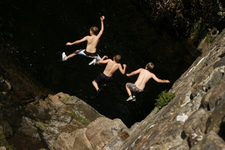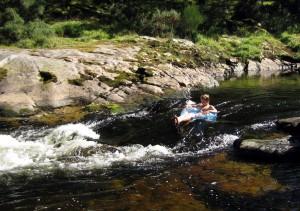
There’s nothing inherently dangerous about wild swimming, but you should always be careful around water with children. Try to chose a river or lake beach with a gently shelving slope, and make sure you go in and check for depth and deeper holes, before you let little ones paddle. There’s also more about how to have fun wild swimming with families here. But for our main safety tips, read on.
Cold water does reduce your swimming ability, at least until you get used to it. So children should stay close to the shore and increase your range slowly. You should assume that you can swim about a tenth of the distance in cold water that you can in a warm pool. Cold waters affects people in different ways so you should stay close to the bank until you have got used to cold water swimming and know how your body will react. Don’t get too cold – warm up with exercise and warm clothes before and after a swim. Shivering is not good and is a sign of mild hypothermia. Wetsuits can be a great help and allow you to stay immersed indefinitely – there are some great mini wetsuits for children which also add buoyancy.
Water quality in UK rivers and lakes is generally good. However, never swim in canals or urban areas, or in rivers straight after a flood. Be cautious of water quality during droughts too. If you are concerned about water quality keep cuts and wounds covered with waterproof plasters and keep you face out of the water – do breast stroke.
Never swim alone and keep a constant watch on weak swimmers. This is particularly true at beachy areas, where water depth can vary unpredictably and children can find themselves suddenly out of their depth.
Never jump into water you have not thoroughly checked for depth and obstructions. And always make sure you know how you will get out before you get in
Watch out for boats on any navigable river. Wear a coloured swim hat so you can be seen
Wear footwear if you can. You’ll have more confidence, and be better able to explore, plus you’ll protect your feet (e.g. old trainers, jelly beans etc are fine)
Make sure you bring light weight towel, a picnic rug, midge repellent, suntan lotion (water proof P20 is great), sunhats and a plastic bag for all your wet kit.
Inflatables are popular but make sure people won’t drift away on them, especially non-swimmers. A buoyancy aid is safer, and fun too.
You will find plenty of places where there are No Swimming signs and notices, yet people regular swim and always have. The signs usually there to limit land owners’ liability, in case someone has an accident and tries to sue. If you are asked to move on, do so politely. Never swim near fishermen – they have paid for the privilege and they value their peace.
If you come across a magical pool on a walk it’s quite possible to swim even without any kit. Wear your undies or go naked if it is secluded. If you have no towel wipe most of the water off with your hands then sacrifice one item of clothing to dry yourself or travel with a small, light cotton sarong.















